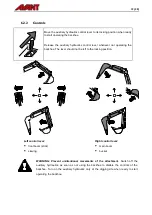
8 (28)
Remember to wear proper protective clothing:
The noise level at the driver's seat may exceed 85 dB(A). Wear hearing
protection while working with the loader.
Wear protective gloves.
Wear safety boots whenever working with the loader.
Wear safety glasses when handling hydraulic components.
When working at construction sites, a safety helmet is recommended and may
be mandatory in addition to the falling objects protective structure (FOPS) on
the loader. Find out about other necessary safety equipment at your specific
work site.
Safe stopping of the attachment, before going near the attachment:
WARNING:
Always stop the attachment following safe stopping procedure before
leaving the driver's seat. Safe stopping procedure prevents all unintentional
movements of the attachment. Note that the loader boom can move down even if
the engine of the loader is turned off. Safe stopping procedure:
Lower the boom and the attachment on the ground.
Shut down the loader engine and lock the parking brake.
Release residual pressure from the hydraulic system; move all hydraulic control
levers to their extreme positions a couple of times.
Prevent starting of the machine, remove ignition key.
DANGER:
Never allow anyone to get under the raised load or the loader, or backhoe boom
or bucket. Keep in mind that the loader and backhoe booms can be lowered or tilted even if
the engine has been shut down (crushing hazard). The loader or the backhoe are not
intended to be left to keep a load elevated for longer periods. Always lower the attachment
to a safe position before leaving the driver's seat.
Special training, license, or permit may be required to operate the equipment at your
area. Depending on area and work site, local requirements may mandate that the
operator has received proper training on how to operate the equipment safely and about
safety precautions, including action during emergencies. Find out about possible
requirements before operating the equipment.



























